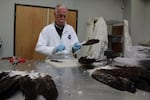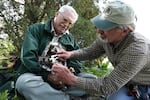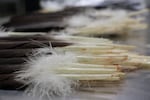
Eagle feathers and parts are sent to the National Eagle and Wildlife Property Repository for redistribution to Native Americans for ceremonial use.
Kris Millgate
It’s mud season in eastern Idaho. Winter is over. The reservoirs are filling, the ground is greening and the eagles are returning.
These birds are why researcher Michael Whitfield is in the woods.
“Every spring there’s that anticipation of seeing if such-and-such eagle is still around,” says Whitfield, the principal Idaho researcher at the Greater Yellowstone Ecosystem Project. “If they’re successfully nesting and if they survive.”
Whitfield keeps track of more than 80 eagle nests. He also pays attention to how these raptors die. Collisions with cars or power lines are the most common reason. But there’s another, more sinister cause: People kill them for money. They poison them or shoot the eagles, then collect their bodies.

Bud Alford, retired U.S. Forest Service biologist holds an eaglet while Michael Whitfield, Greater Yellowstone Project principal researcher, measures the bird’s beak.
Courtesy Kris Millgate/Tightline Media
Regardless how an eagle dies, federal law prohibits people from possessing any of its body parts. That applies to an eagle that was poisoned or an eagle carcass someone happened upon during a walk in the woods.
And yet, Rob Cavallaro of the Idaho Department of Fish and Game sees evidence every day that people are disregarding that law.

Eagle carcasses are sent to the National Eagle and Wildlife Property Repository near Denver, Colorado. The repository received more than 2,300 eagles in 2014.
Kris Millgate, EarthFix
“It’s not uncommon for eagles to come in with parts missing, particularly the feet,” says Cavallaro, a regional wildlife biologist. One of his jobs is to store dead eagles in a freezer at his Idaho Falls office while a cause of death is being determined.
“Eagle parts, especially the talons, are pretty impressive and people see those and think they are able to keep that part, but they are not,” he says.
Eagle parts can be worth big bucks. In the 2011 trafficking case known as
, a bald eagle carcass sold for $1,000. A single feather went for $500. The case took two years to close.

Dan Rolince, U.S. Fish and Wildlife Service Office of Law Enforcement supervisor, inspects a bottle of snake wine. It’s one of the 1.5 million pieces of wildlife trafficking evidence in the National Eagle and Wildlife Property Repository.
Kris Millgate, EarthFix
“Making a wildlife case is extremely difficult,” says Dan Rolince, U.S. Fish and Wildlife Service Office of Law Enforcement supervisor. “Typically the victim does not have the opportunity to call you and tell you something happened.”
Case evidence ends up at the
National Eagle and Wildlife Property Repository in Colorado
. It holds more than a million pieces of evidence from wildlife trafficking cases handled nationwide. Half of the repository is dedicated just to eagles and eagle parts.
Of all the evidence at the repository, only the remains of eagles are repurposed.
“When we get boxes in, which happens every day, one of our staff members will evaluate the condition of that bird and determine which part, or [if] the whole bird, could be used to fulfill an order,” Rolince says.
The orders he’s talking about most often come from Native American tribes. They can legally possess eagle feathers and parts for use in their ceremonies. Some of the feather requests are so color specific that there’s a five-year wait. The high demand has helped create a black market for eagle feathers and other parts.

The National Eagle and Wildlife Property Repository filled almost 4,000 eagle orders in 2014. Order requests come from Native Americans on a first come first serve basis. There is a five-year wait for some color-specific feather requests.
Kris Millgate, EarthFix
When poachers are caught, jail time is not long term. Operation Rolling Thunder was one of the agency’s biggest eagle cases. The 12 people convicted for wildlife trafficking went to jail for a total of 55 months. That’s an average of four and a half months per person. Rolince says he’s not deterred by the short sentences.
“I firmly believe the emphasis we are placing on large-scale trafficking is having a positive effect,” he says. “That’s why we have to get out there and just keep digging.”
Special Report

There's more in our series about poachers, traffickers, and the fight to stop their crimes against nature.
In eastern Idaho, Whitfield keeps banding birds, hoping his hands are the last hands that ever touch a wild eagle.
"People recognize the bald eagle for the majesty that it is," Whitfield says. "The fact that it's our national symbol wasn't an accident. Bald eagles are symbols of the wildness of this place. I think we need to do all we can to sustain this resource."